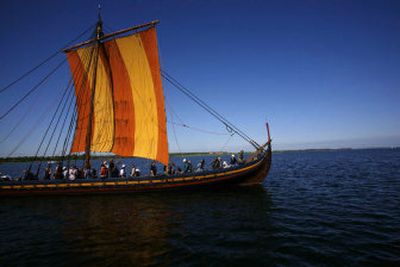Viking warship replica to set sail

ROSKILDE, Denmark – On the skipper’s command, deckhands haul in tarred ropes to lower the flax sail. Oars splash into the water. The crew, grimacing with strain, pull with steady strokes sending the sleek Viking longship gliding through the fjord.
A thousand years ago, the curved-prow warship might have spewed out hordes of bloodthirsty Norsemen ready to pillage and burn.
This time, the spoils are adventure rather than plunder.
The Sea Stallion of Glendalough is billed as the world’s biggest and most ambitious Viking ship reconstruction, modeled after a warship excavated in 1962 from the Roskilde fjord after being buried in the seabed for nearly 950 years.
Volunteers are preparing it for a journey across the legendary Viking waters of the North Sea – leaving Roskilde in eastern Denmark on July 1 and sailing 1,200 miles to Dublin, which was founded by Vikings in the ninth century.
“It’s like a banana boat. It moves like a snake,” crew member Preben Rather Soerensen, 42, said after a recent test sail in the Roskilde fjord.
The crew will explore the challenges of spending seven weeks in an open vessel with no shelter from crashing waves, whipping wind and drenching rain. Working in four-hour shifts, the history buffs and sailing enthusiasts will have to steer the 100-foot-long ship through treacherous waters with a minimum of sleep, comfort and privacy – just as the Vikings did.
“They must have been incredibly tough to do what they did,” said 24-year-old crew member Triona Nicholl, an archaeologist from Dublin. “We all have waterproof gear. We have radios and life jackets and all the stuff. They must have been hardier people.”
The Vikings turned to the stars and their ancient Norse gods for help as they navigated across the open sea, reaching as far as Iceland and North America. Many perished in the hostile waters of the North Atlantic.
This crew puts their faith in modern technology: a GPS satellite navigation system and radar. They wear baseball caps and jackets rather than helmets and chain mail shirts. Mobile phones are allowed, but no battle axes.
Nevertheless, the crew is likely to feel they have been transported back a millennium when the voyage begins, although it will be accompanied by a modern support vessel with medical and rescue experts.
The Viking boat has the curved hull and single square sail that typified Norse longships, which were designed to sail on both open seas and shallow rivers.
Using replicas of Viking era tools – chisels, knives, spoon bits and axes – craftsmen built the 8.25-ton Sea Stallion using 5,250 cubic feet of oak and 7,000 hand-forged iron rivets.
“Within a certain framework, we knew how they built the ship and how the missing parts should be,” said Erik Andersen, 68, who designed the replica. “The only guesswork was the color of the ship and the sail.”
The builders settled for a brown-colored hull and a red-and-yellow sail, drawing inspiration from the famed Bayeux tapestry in France, which depicts the 11th century Norman conquest of England. The Normans were descendants of Viking settlers in northwestern France.
The ship proved remarkably stable during trials off Roskilde on May 5. Powered by up to 30 pairs of oars, the Sea Stallion – Havhingsten in Danish – sliced through the waves without wobbling.
The voyage across the North Sea, passing north of Scotland and down the famously ill-tempered Irish Sea, will test both the crew and their ship.
The goal is to sail nonstop to Dublin, but the plan could change depending on the weather.
The Sea Stallion will sail around the northern tip of Jutland and across the North Sea to the Orkney Islands, north of Scotland. From there, it is to veer south at Cape Wrath on Scotland’s northern tip and down the Irish Sea to Dublin.
The crew – mostly volunteers from Scandinavia, Britain, Ireland, the United States and Canada – will eat, sleep and work in extremely close quarters. When nature calls, the solution is a portable toilet near the mast or over the side of the ship.
“Privacy is a very big problem. We’re 65 people living very close for long time,” said Erik Nielsen, a 64-year-old volunteer from Toronto. “You deal with it. It is manageable.”
The 78 men and 22 women will take turns sailing the ship on the seven-week voyage. Many will remain onboard from start to finish, said Rather Soerensen, the project manager.
“They have to know something about square sails. And they have to be very socially competent,” he said.